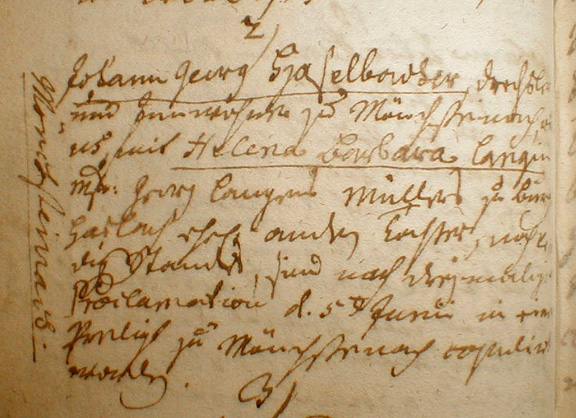Marriage Record of Johann Georg and Helena 1753

This is the marriage record of Johann Georg Hasselbacher and Helena Barbara Lang(in). It comes from the church book in Munchsteinach. The month and date are June 5 and the year (not present above) is 1753. A complete translation is available here. Johann is presented as a widowed resident of Münchsteinach, and by his occupation as drechsler. The name "Georg Langens" on line 4 refers to Helena Barbara's father who is a master miller in Burghaslach. The seventh line speaks of their Proclamation (?latinized writing) on 5th June.
[Here is a full transcription from the Wendel Archive:
“1753 Page 152, No. 2 Mönchsteinach- Johann Georg Haselbacher, Drechsler und Innwohner zu Mönchsteinach. viduus, mit Helena Barbara Langin, Mstr. Georg Langens, Müllers zu Burghaslach ehel. anderen Tochter, noch ledigen Standes, sind nach dreymaliger Proclamation d. 5 Junii mit einer Predigt zu Mönchsteinach copylirt worden.” (The word written vertically is Mönchsteinach."
I would not have been able to read all of that in part because of the page gutter, but here is my translation: Johann Georg Haselbacher, turner and inhabitant of Mönchsteinach, widow, with Helena Barbara (who is) the legitimate (ehel.) daughter of Georg Lang, miller from Burghaslach, (who is) single, and after the three readings of the bans was married June 5 with a sermon.
You can appreciate the challenges presented by these old books. It is not just written in another language, but in a form of handwriting that most modern German speakers have trouble with. Would you have even recognized the name Hasselbacher? (Even if the recorder spells it correctly in the first place: never a given! Look also at the spelling of Hasselbacher in Peter's birth record. One 'a' or two?) Such records are sometimes a combination of Latin and German language and writing styles both. Look at the different style of the initial 'H' in Hasselbacher and Helena.
You will have noticed in some of old family trees, that aside from phonetic alternates, other spelling variarions are offered, especially of women's names. I initially thought these alternates were documented by family historians to indicate that there was some question of what the "real" name was. For example, in the above and in Peter's birth record, Helena's name is written "Langin." In other documents of this time I found female Hasselbachers names "Hasselbacherin." It now occurs to me that this is just a part of their grammer. German, French, and other languages categorize nouns by gender groups. Modern German still has feminine, masculine, and neuter categories. Different prefixes, articles and word endings are part of such genderized systems of language. That said, I do not understand the spelling of Georg's name above. I am probably the last person to realize this, but I bet I am not the only beginning genealogist to be confused!
I have acquired a few hundred of such documents and edited 18 Jun 2010more keep turning up. My intent is to put them all up on this website. Any sugestions about how best to do that will be appreciated. Database? Photo album? Table? How much demand is out there for them? We would also need some folks who can help with translation for the job to be meaningful.
This is great fun!
Peter Hasselbacher
April 7, 2007; edited 18 Jun 2010